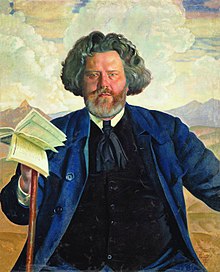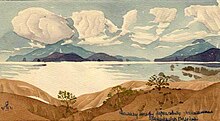Maximilian Alexandrovich Voloshin

Maximilian Voloshin ( Russian Максимилиан Александрович Волошин ; born May 16 . Jul / 28. May 1877 greg. In Kiev ; † 11. August 1932 in Koktebel ) was a Russian - Ukrainian poet, landscape painter and writer. As an author, he is counted in the so-called silver age of Russian literature . In painting he devoted himself primarily to the landscapes of the Crimean peninsula , on which he lived for many years.
Life
Early years
Maximilian Alexandrowitsch Woloschin was born in Kiev, then part of the Russian Empire, as the son of the lawyer and councilor Alexander Kirijenko-Woloschin († 1881), who came from a Dnieper Cossack family and whose German-born wife Jelena Woloschina (née Glaser) was the translator, born. Voloshin spent his early childhood in Taganrog and Sevastopol . As a child, after the death of his father, he moved with his mother to Moscow and first attended school there, but then the family moved to Feodosiya in the Crimea, where Voloshin graduated from high school. In 1893 Voloshin and his mother moved to the Black Sea settlement of Koktebel , which would later become his adopted home for many years.
As a schoolboy Voloshin showed an interest in literature and wrote longer essays. At the age of 18 he published a poem for the first time and began to translate works in foreign languages (including by Heinrich Heine ) into Russian.
In 1897 Voloshin went back to Moscow and took up law studies at Lomonosov University , initially following in his father's footsteps. However, his devotion was essentially writing. He published his first articles in various Moscow magazines. He was suspended from the university and banned from Moscow for allegedly participating in student protests. He then traveled to Europe and visited, among others, Italy , Switzerland , France and Germany , where he often had to travel on foot and stay in night shelters due to lack of money . In 1900 he resumed his studies in Moscow and was arrested again for participating in student organizations. After his release, Voloshin went to Central Asia to work on the construction of the Orenburg - Tashkent railway .
From there, Voloshin came back to Europe in 1901 and temporarily settled in Paris , where he attended lectures at the Sorbonne and learned painting from the Russian artist Jelisaweta Kruglikowa, who was based there . He also continued to write poetry. Through various artists living in Paris, he became acquainted with the main artistic and literary currents of Western European culture at the beginning of the 20th century. At the same time he began to be interested in Buddhism , theosophy and occultism .
In 1903 Voloshin returned to Russia. There he began to publish his essays in Russian art magazines. At the same time, his poems appeared to the wider public for the first time. During those years, Voloshin met a number of other well-known poets of the era, including Valeri Bryusov , Alexander Blok, and Andrei Bely . In 1905, Voloshin witnessed the St. Petersburg Bloody Sunday , during which the guards shot at the peaceful demonstrators at close range in front of the Tsar's palace, killing over 100 people. This “Bloody Sunday” radicalized the protest movement and the revolution spread across Russia. This experience formed his attitude towards the revolution , which he had represented all his life. In 1906 Voloshin married the painter Margarita Sabaschnikowa and moved to St. Petersburg with her . He helped young and still unknown authors, including Marina Tsvetaeva and Mikhail Kuzmin , to publish their first works. His meeting (1905) with Rudolf Steiner made a great impression on him and in the years that followed he traveled with his wife to many of his lectures.
Around 1907 Voloshin got into a deep life crisis, which was triggered by the approach of his wife Margarita to the poet Vyacheslav Ivanov and his wife Lydia Zinovieva-Annibal. Relations became so complicated that Voloshin withdrew to Koktebel. From then on, his marriage to Margarita was considered broken and soon divorced. He later married his second wife, Maria Stepanovna Sabolotskaja († 1976). During this time he found his poetic way. From 1909 he worked as a literary critic for the magazine Apollon . In 1910, the Poems Collection 1900–1910 was the first printed book by Voloshin. His essays on art and contemporary painters, his cultural studies essays are still relevant today due to his unusual approach.
Until 1914 he published other books, mainly with translations and collections of earlier magazine publications. However, this was overshadowed by the temporary boycott of his works by magazines and publishers after Voloshin published a critical essay on one of Ilya Repin's paintings in 1913 .
Shortly before the outbreak of the First World War , Voloshin traveled again to Switzerland to work with many artists from the warring nations on the construction of the first Goetheanum . He then went to Paris, where he met Pablo Picasso , Diego Rivera , Amedeo Modigliani and many other artists of the time. His pacifist poetry collection Anno mundi ardentis was published in 1915 . In a letter to Minister of War Sukhomlinov , Voloshin expressed that, among other things, he refused to take part in the acts of war because the vocation of the poet and the artist was incompatible with violence against people. In 1916 he finally returned to Russia.
Life in Koktebel
As early as 1907, Voloshin's mother bought a house in Koktebel , the place where he had spent some years of his youth and which inspired him very much in terms of landscape. In the years of the First World War, Voloshin withdrew there more and more often and finally settled in Koktebel in 1917. Occasionally he gave lectures on literature and art in Feodosia and Kerch . Since then, however, he has devoted himself most to landscape painting. He dealt intensively with tempera painting and the watercolor technique . In the period from 1917 until his death, Maximilian Woloschin created a large number of watercolor paintings in which he processed the natural beauty of Koktebel and the surrounding area. The fact that he often gave the pictures names that sound like stanzas of a lyrical poem emphasizes the extremely atmospheric character of the works. Voloshin referred to the collection of his watercolors on Koktebel as The Suite by Koktebel . In total, he painted several thousand watercolor pictures.
In politics, however, Voloshin remained a staunch opponent of war even in his final years. He accepted the October Revolution of 1917 and the resulting social upheaval as an inevitable evil. In the following Russian Civil War , Voloshin once again showed himself to be impartial by repeatedly speaking out in favor of reconciliation between the opponents. He also often gave refuge to persecuted people from both camps in his home. In the 1920s, Voloshin wrote several philosophical poems, continued to work as a landscape painter and promoted authors and artists. Voloshin was responsible for the preservation of monuments of art and science in the Feodossia region and a member of the Russian Poets Association.
Maximilian Woloschin died of pneumonia on August 11, 1932 in Koktebel. A year earlier he bequeathed his house to the Writers' Union of the USSR ; a museum has been located there since 1984. According to his wishes, Voloshin was buried in Koktebel on a hill off the Black Sea coast.
Works (selection)
photos
- Spain. By the Sea (1914)
- Paris. Place de la Concorde at night (1914)
- Two trees in the valley. Koktebel (1921)
- Landscape with Lake and Mountains (1921)
- Pink Dawn (1925)
- Hills Dried Out by the Heat (1925)
- Cyclone on the Moon (1926)
- Leaden Light (1926)
Publications
- Anno mundi ardentis (1915)
- Demony gluchonemye ("The deaf and dumb demons", 1919)
- The Paths of Cain (1921–23) (German translation by Alexander Nitzberg , bilingual edition Russian and German. Dornach, Verlag Die Pforte, 2004, ISBN 9783856361570 )
- Stichi o terrore ("Poems on Terror", 1923)
- Rossija ("Russia", poem, 1924)
See also
literature
- Ilja Ehrenburg : Memoirs. People, years, life. Part I: 1891–1922 , Kindler, Munich 1962, special edition 1965, pages 193–202, ISBN 3-463-00511-5
- Igor Kuprijanov: Sud'ba poèta. Licnost 'i poezija Maksimiliana Volosina , Naukova Dumka, Kiev 1978, OCLC 252432255
- Claudia Wallrafen: Maksimilian Vološin as artist and critic , Sagner, Munich 1982, ISBN 978-3-87690-222-7
- Margarita Woloschin: The Green Snake , Free Spiritual Life, Stuttgart, 2009, ISBN 978-3-7725-2082-2
- Sergej O. Prokofieff : Maximilian Woloschin: Mensch, Dichter, Anthroposoph , Verlag am Goetheanum, Dornach 2007, ISBN 978-3-7235-1279-1
Web links
- Literature by and about Maximilian Alexandrowitsch Woloschin in the catalog of the German National Library
- Website dedicated to Voloshin ( Memento of July 15, 2007 in the Internet Archive ) (Russian)
- Biography at artonline.ru (Russian)
- Large picture gallery (Russian)
- Short biography ( memento of October 11, 2008 in the Internet Archive ) on the website of the University of Potsdam (German)
Individual evidence
- ↑ a b c Biography of M. Voloshin
- ^ Curriculum vitae, data ( memento from October 11, 2008 in the Internet Archive ) on uni-potsdam.de
| personal data | |
|---|---|
| SURNAME | Voloshin, Maximilian Alexandrovich |
| ALTERNATIVE NAMES | Maksimilian Aleksandrovič Vološin; Волошин, Максимилиан Александрович |
| BRIEF DESCRIPTION | Russian poet and painter |
| DATE OF BIRTH | May 28, 1877 |
| PLACE OF BIRTH | Kiev |
| DATE OF DEATH | August 11, 1932 |
| Place of death | Koktebel |




